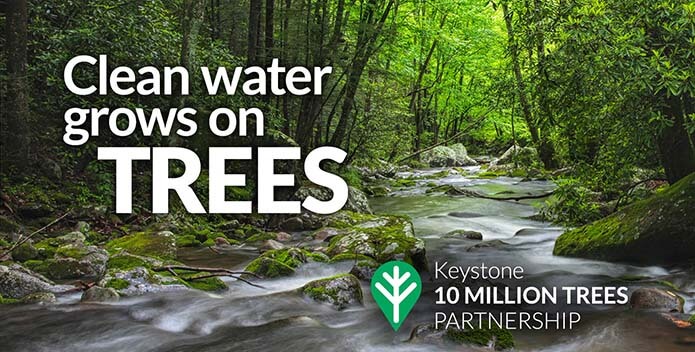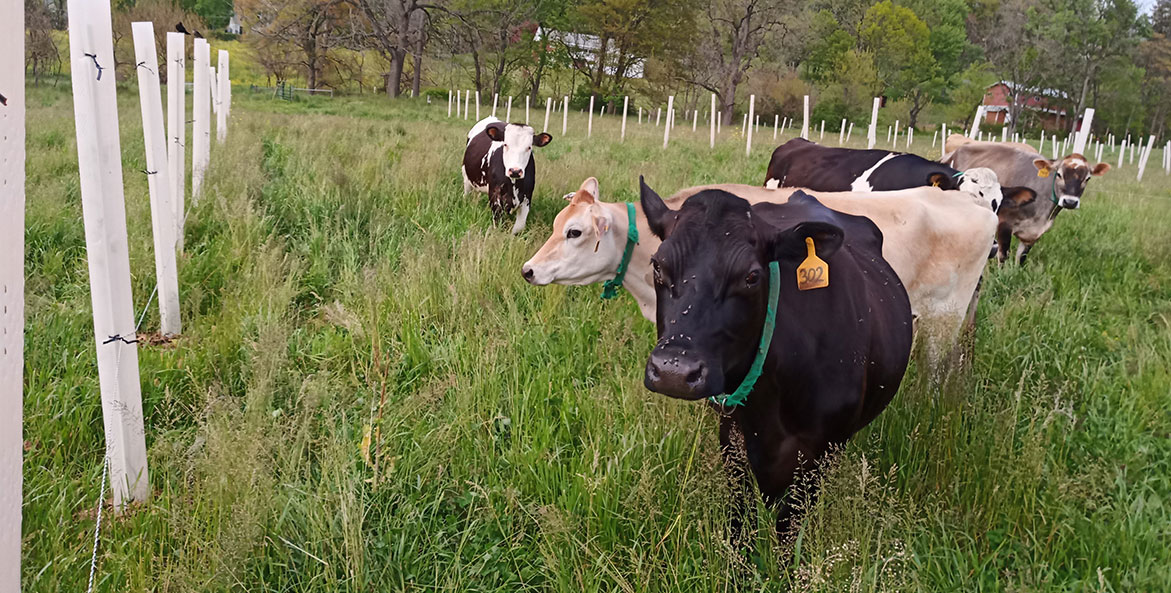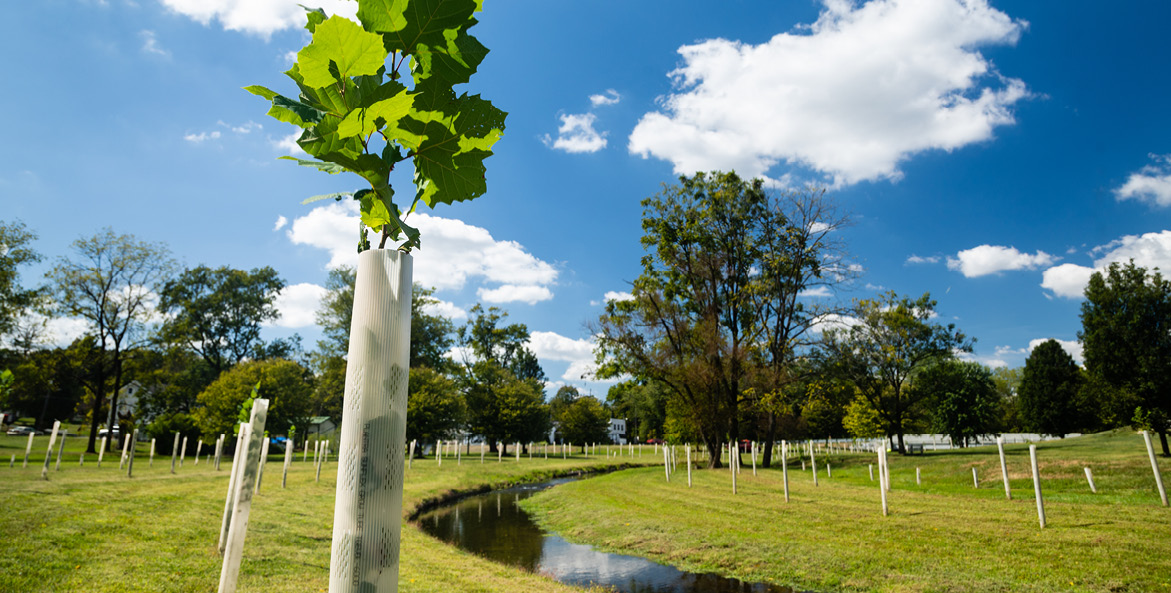Pennsylvania provides half of the freshwater that flows into the Bay and about 25,500 miles of Keystone State waters are impaired by polluted runoff and the legacy of coal mining. Unfortunately, that number continues to grow.
The U.S. Environmental Protection Agency (EPA) has said that Pennsylvania is responsible for 46 percent of the nitrogen, 26 percent of the phosphorus and 31 percent of the sediment that enters the Bay.
The Commonwealth’s nitrogen reduction goal stands at 31 million pounds, and it continues to be significantly behind in meeting its clean water milestones.
As saving the Bay hinges on first saving the rivers and streams in Pennsylvania, CBF believes the work of many hands planting many trees can make a difference in getting the Commonwealth back on track.
CBF launched the Keystone 10 Million Trees Partnership in 2018, focused on Pennsylvania’s Clean Water Blueprint goal of planting 95,000 acres of forested buffers by the end of 2025.
Adding 10 million new trees alongside streams, streets, and other priority landscapes in Pennsylvania’s portion of the Bay watershed would accelerate the Keystone State as much as two-thirds toward the 95,000-acre target.
Since 2018, cumulative efforts by CBF, the partnership and others across Pennsylvania have planted roughly 1.74 million trees.
Why Trees?
Trees are among the most cost-effective tools for cleaning and protecting waterways by filtering and absorbing polluted runoff, stabilizing streambanks, and improving soil quality. Placed in parks, municipal properties and other urban and suburban settings, trees absorb and clean stormwater, reduce flooding, and help restore abandoned mine land.

Keystone 10 Million Trees Partnership intends to plant 10 million trees in Pennsylvania by 2025.
iStock.
The partnership is a collaborative effort of 147 partner groups representing national, regional, state, and local agencies, conservation organizations, watershed groups, conservancies, outdoors enthusiasts, businesses, and individuals.
Special emphasis is placed on plantings in Lancaster County and four other counties in southcentral Pennsylvania, where a substantial amount of nitrogen pollution is generated.
The partnership’s success is rooted in the determination of many hands and on full display during COVID-19 restrictions. Of 95,000 trees distributed for spring planting in 2020, about 84,000 went into the ground. The remaining 11,000 trees are being kept in partner greenhouses and will grow into larger stock for future plantings.
“Without volunteers, most partners went out and planted by themselves,” says CBF’s Brenda Sieglitz, who manages the partnership. “Most of their volunteers became people in their households, their spouses and children who they could safely have contact with. They went out during work hours and on their own time to ensure that they could get as many trees planted as possible this spring.”
Focus now shifts to fall plantings and about 47,000 trees are being delivered in September to pick-up points. Because of spring cancellations, the fall 2020 number of trees is more than double what was planted in fall of 2019.
Tree numbers are only going to grow.
What the Future Holds
For the next two years, CBF issued requests for proposals (RFP) and is planning to spend about $2.6 million on 710,000 trees, shelters, and stakes for the partnership. CBF contracted for 210,000 trees, stakes, and shelters for 2021.
For 2022, CBF awarded bids to four growers for a total of 500,000 trees and supplies. Forward contracting is new to CBF and provides a boost to businesses from guaranteed sales, and the diversity of the plants to CBF partners.
“It helps with structure and provides some certainty outside of acts of God and crop failure,” says Jim Mackenzie, President and Co-owner of Octoraro Native Plant Nursery in Lancaster County. “It provides some assurances for both parties and that is a big deal. That by itself is important.”
Efforts by many hands to plant many trees in the Commonwealth will take shape in a variety of programs and benefit from a growing number of funding sources.
A grant by the National Fish and Wildlife Foundation awarded to CBF and matching funds will provide nearly $2 million to plant and maintain 360 acres of new trees and boost efforts in eight Pennsylvania counties toward achieving local plans for cleaner water.
“It will take planting trees in the right places and with the right partners to reach buffer goals in clean water plans set by key counties,” says Shannon Gority, CBF Executive Director in Pennsylvania. “With this investment by NFWF and so many dedicated partners who share a commitment to clean water, counties will be better prepared to take action to protect and restore local waters. That benefits all Pennsylvanians and everyone else downstream to the Bay.”
The Keystone 10 Million Trees Partnership is also supporting the Chesapeake Conservancy on its NFWF grant that will result in full-farm restoration on 25-30 farms in Pennsylvania. The project has the potential to serve as a national model for coordinating on-the-ground implementation with high-resolution mapping to improve the health of streams so that they can be removed from Pennsylvania’s impaired streams list.

Cows checking out silvopasture trees and shelters at Fiddle Creek Dairy Farm in Lancaster County, PA.
Austin Unruh
CBF is also leading a three-year study of the practice of silvopasture, supported by a grant from the Northeast Sustainable Agriculture Research and Education Program Research under the U.S. Department of Agriculture.
This research will look to guide farmers on how to get productive trees established in active pastures given predation, livestock damage, limited resources, and different types and quality of forage and soils.
“You are putting more factors into your pasture, but there could be some serious benefits, long-term, especially economic,” says Molly Cheatum, CBF Restoration Program Manager in Pennsylvania and the study leader. “You get healthier soils, grasses and trees. You are also reducing polluted runoff and sequestering carbon.”
Building better buffers is an ongoing commitment for the partnership.
“Stroud Water Research Center is pleased to partner with CBF to evaluate methods for buffer establishment,” says David Wise, Watershed Restoration Manager at Stroud. “The goal is to test methods with potential to reduce costs while improving buffer success and reducing use of herbicides.”
Tests are evaluating the use of stone mulch to protect trees from rodents without the use of herbicides, a new tree shelter that may perform as well as leading types at significant savings, pressure-treated oak stakes to reduce high failure rates of stakes that support tree tubes, and whether reduced mowing, which can be expensive, can still provide necessary protection against damage by competing vegetation and rodents.
A major reason Pennsylvania continues to lag so far behind in implementing clean water practices is a lack of adequate investments of financial and technical assistance at the state and federal levels.
The Commonwealth’s Phase 3 Watershed Implementation Plan, which would achieve 73 percent of the nitrogen reductions needed to meet its Blueprint goals, has an annual funding shortfall of $324 million.
Agriculture is the greatest source of pollution to Pennsylvania waters, and farmers stand ready to do the right thing, understanding that keeping soil on the land is good for clean water and farm sustainability. But they cannot afford to do it all on their own.
Past Successes
When it comes to adding trees and other important pollution practices on farms and other important landscape, CBF has been proud to work collaboratively to establish a few funding streams.
CBF was instrumental in the Pennsylvania General Assembly’s passage last year of the Keystone Tree Restricted Account, which created a voluntary $3 check-off box on Pennsylvania’s driver’s license and vehicle registration online renewals to buy, plant, and maintain more trees across the Commonwealth. These voluntary donations will support the existing TreeVitalize and Riparian Forest Buffer Grant programs through the Department of Conservation and Natural Resources.
CBF, Pennsylvania Farm Bureau, Sand Penn State Agriculture and Environmental Center worked jointly to propose programs that would direct funding to conservation districts, and provide the needed technical assistance to farms and the flexibility to determine conservation practices specific to local watershed needs.
The bill introduced by State Senator Gene Yaw (R-Lycoming) will create the Agricultural Conservation Assistance Program (ACAP). ACAP will provide the funding support that farmers in Pennsylvania want and need so they can keep soil on the land, reduce pollution, and protect their long-term viability.
To learn more about the Keystone 10 Million Trees Partnership visit www.TenMillionTrees.org.




